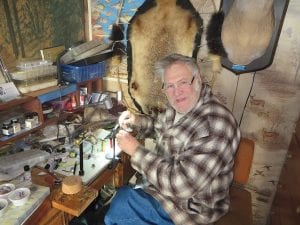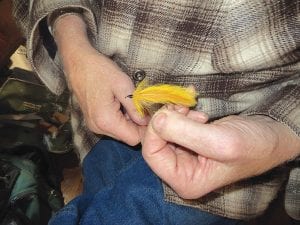If patience is a virtue, then Dave Asproth is a very virtuous man.
After 54 years of practice, Asproth has learned a thing or two about tying flies, or “dressing flies” as the skill is called by its practitioners.
Last fall the Grand Marais resident attended the 48th Annual International Fly Fishing Fair held September 24-28 in West Yellowstone, Montana. He was the only Minnesota representative to demonstrate at the convention. This was the 23rd international fly tying event that Asproth has attended.
At the show Asproth showed how to tie the Hexagebia limbata, the largest of the mayfly species. During the hatch in late June these mayflies are plucked off of the top of the water by trout rising so fast and furiously that it looks like raindrops are falling, especially so at sunset.
The Cook County News-Herald recently visited with Asproth in his fly-tying studio to learn a little bit more about our community’s master fly tier.
Asproth, who grew up in Mahtowa, Minnesota, first learned to dress flies when he was 15 years old, visiting Charlie Hayes’ fly shop in Lake Nebagamon, Wisconsin. Following initial lessons, Asproth joined the United Fly tiers group.
About 20 years went by before he started to exhibit his skills to the public. Since then he has taught at North House Folk School (for 16 years) and he has taught fly-tying and fly-fishing courses as well as given fly-casting instructions to those wishing to learn how to ply the waters with artificial flies.
When asked what brought him to Cook County, Asproth said, “I came here in 1974 after reading an ad that someone up here needed a baker. First I went to work at the Kove, and then I worked 15 years for The Loafer as a baker. I also worked for a bakery and pizza shop on the hill (near the Harbor Light) and spent one year running the Beaver House for Guyal Anderson before he sold it to the Cronbergs. I also worked for about nine months in the woods running a skidder and a clipper for the Bloomquists. I graduated from Dunwoody Institute with a degree in cake decorating in 1963. I guess I was about 35 years old when I moved to the county.”
Oh, Asproth also worked full-time at Hedstrom Lumber Company for 30 years, retiring several years ago. In his spare time, Asproth was a longtime member of the Cook County Search and Rescue squad, a trapper, a hunting and fishing guide, (he guided actor Chuck Norris one fall) and was a float-tubefishing pioneer in Cook County.
Asproth also made wedding cakes on the side and sold them to young couples at a price that fit their budget (or lack thereof).
Besides his love of baking and the outdoors, Asproth is also a passionate supporter of Cook County High School sports, although he is torn when the kids are playing Barnum, his alma-mater.
Diabetes has slowed him down in recent years. During a two-year eight-month fight to cure a staph infection, he had two toes taken off and two bones removed from his right foot. He also had skin grafts, but nothing worked and the infection continued to spread. Finally he had to have his lower leg taken off 10 inches below his knee. Last January he was in the hospital recuperating from one of his numerous operations when his pipes froze and broke, flooding his house.
“I couldn’t move back home until my house was fixed at the end of June; that was tough. I spent most of the time in a swingbed at the hospital,” Asproth said, adding that doctors also discovered that sometime in the recent past he had suffered a mild heart attack.
“But I am feeling a lot better now. I’m tying flies and selling some of them. I get up in the morning and start tying, even before church,” he said with a smile.
As far as his health, Asproth was just in Duluth on December 2 for a checkup that went well. He also said that he was “getting used to walking on my prostheses.”
Currently Asproth is working on tying flies for a couple who will be traveling to Argentina to fish.
“I’m making them a lot of different kinds of flies because we don’t know what will work down there,” Dave said.
Just how many types of flies does Dave tie? “Between 400 and 500. I tie a lot of varieties I guess,” he said with understatement.
To make something this small takes a lot of skill and attention to detail. Sitting at his bench, Asproth uses a clamp and sometimes a magnifying glass, patience and large nimble fingers to wield his craft.
He uses natural materials, including fur from deer, fox, rabbit, mink, muskrat, otter, and squirrel. He also uses feathers from ducks, geese, partridge and other birds, as well as threads, yarns, cork and balsa.
Some of the tools he uses include a pliers, hackle pliers, bodkins, hackle gauges, toothpicks, dubbing twisters, whip twisters, wing burners, bobbins and threaders.
Starting with a small hook, a No. 8, Asproth weaves his magic and before long a caddisfly emerges. The small moth-like insect is a favorite food for fish across the country. All around him sit displays of the many varieties of flies he has fashioned over the years. Some are so small it’s hard to imagine how anyone could make them. Many are colorful, beautiful works of art.
Asproth has been called one of America’s best fly tiers. He has made friends across the country and fished streams from Arkansas to the Rocky Mountain states of the west. The best in his field know him and many call him friend.
“I’ve been really lucky, really blessed by the people that I have met here, the friends that I have made everywhere. It’s been a good life, and God willing, I hope I have some more years left,” Asproth said as he smiled, then bent down again and began working on a new creation, patiently and carefully and skillfully weaving thread, feathers and fur together around a small hook, a fly caster’s dream coming to life from the large hands of a virtuous, patient, soft-spoken, very kind man.




Loading Comments